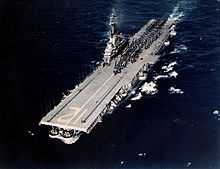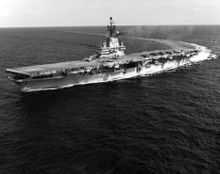SCB-27
SCB-27, or "Two Seven-Alpha"/"Two Seven-Charlie," was the United States Navy designation for a series of upgrades to the Essex class aircraft carriers (both the short-hull and long-hull (Ticonderoga) versions), conducted between 1947 and 1955. These upgrades were intended to allow the World War II-era carriers to operate jet aircraft.
Modifications

Officially, Ship Characteristics Board Program 27 proper referred to the completion of USS Oriskany (CV-34), left unfinished at war's end, to a heavily revised design; reconstructions of earlier ships were programs SCB-27A and 27C. The SCB-27 modernization was very extensive, requiring some two years for each carrier. To handle the much heavier, faster aircraft of the early jet-era, the flight deck structure was significantly reinforced, able to support aircraft weighing up to 52,000 pounds (23,587 kg), namely the North American AJ Savage. Stronger and larger elevators, much more powerful catapults, and new Mk 5 arresting gear were installed. The original four twin 5"/38 gun mounts were removed, clearing the flight deck of guns. The new five-inch gun battery consisted of eight weapons, two on each quarter beside the flight deck. Twin 3"/50 gun mounts replaced the 40mm guns, offering much greater effectiveness through the use of proximity fuzed ammunition. The reconstruction eliminated the difference between "short-hull" and "long-hull" ships; all now had similar clipper bows.
The island was completely redesigned, made taller, but shorter in overall length with the removal of its gun mounts. In addition, the boiler uptakes were rebuilt and angled aft to accommodate a single radar and communications mast atop the island. To better protect aircrews, ready rooms were moved from the gallery deck to below the armored hangar deck, with a large escalator on the starboard side amidships to move flight crews up to the flight deck. Internally, aviation fuel capacity was increased to 300,000 US gallons (1,135,624 L) (a 50% increase) and its pumping capacity enhanced to 50 US gallons (189.3 L) per minute.[1] Fire fighting capabilities were enhanced through the addition of two emergency fire and splinter bulkheads to the hangar deck, a fog/foam firefighting system, improved water curtains and a cupronickel fire main. Also improved were electrical generating power, and weapons stowage and handling facilities. All this added considerable weight: displacement increased by some twenty percent. The armor belt was removed and blisters were fitted to the hull sides to compensate, widening waterline beam by eight to ten feet. The ships also sat lower in the water, and maximum speed was slightly reduced, to 31 knots.
Modification sub-types

The two sub-types of SCB-27 modifications were primarily a result of changes in catapult technology in the early-1950s. SCB-27A vessels utilized a pair of H 8 slotted-tube hydraulic catapults, while the later SCB-27C vessels were fitted with a pair of C 11 steam catapults, a British innovation (in fact the first four installed, on USS Hancock and USS Ticonderoga, were British-built). To accommodate the catapult machinery, the SCB-27C vessels were slightly heavier (43,060 vice 40,600 tons) and after bulging wider abeam (103 vice 101 feet) than their SCB-27A sisters. Additionally, the SBC-27C carriers were equipped with jet blast deflectors, deck cooling, fuel blending facilities, emergency recovery barrier and storage and handling for nuclear weapons, which was not included in all of the SCB-27A carriers. Under SCB-27C the No. 3 (after) elevator was moved to the starboard deck edge; this elevator was located further aft on the first three SCB-27C ships than it was on the ships which received it concomitantly with an angled flight deck under the SCB-125 program.[1]
The greater capacity of steam catapults meant that the 27C ships were able to serve as attack carriers through the Vietnam era while their hydraulic-equipped 27A sisters were relegated to antisubmarine duties.
Program history
USS Oriskany (CV-34), laid up incomplete at the conclusion of World War II, served as the prototype and was re-ordered to the SCB-27 standard. All of the SCB-27 modernized Essex carriers, save USS Lake Champlain (CV-39), were further modified under the SCB-125 modernization program.
Modified vessels
Source:www.history.navy.mil [2]
_hangar_deck_escalator_1992.jpg)
| Program | Shipyard | Work Began | Recommissioned | |
| USS Oriskany (CV-34) | SCB-27 | New York | Aug 1947 | Sep 1950 |
| USS Essex (CV-9) | SCB-27A | Puget Sound | Feb 1949 | Jan 1951 |
| USS Wasp (CV-18) | SCB-27A | New York | May 1949 | Sep 1951 |
| USS Kearsarge (CV-33) | SCB-27A | Puget Sound | Feb 1950 | Feb 1952 |
| USS Lake Champlain (CV-39) | SCB-27A | Norfolk | Aug 1950 | Sep 1952 |
| USS Bennington (CV-20) | SCB-27A | New York | Dec 1950 | Nov 1952 |
| USS Yorktown (CV-10) | SCB-27A | Puget Sound | Mar 1951 | Feb 1953 |
| USS Randolph (CV-15) | SCB-27A | Newport News | June 1951 | Jul 1953 |
| USS Hornet (CV-12) | SCB-27A | New York | July 1951 | Sep 1953 |
| USS Hancock (CV-19) | SCB-27C | Puget Sound | Dec 1951 | Feb 1954 |
| USS Intrepid (CV-11) | SCB-27C | Newport News | Apr 1952 | Jun 1954 |
| USS Ticonderoga (CV-14) | SCB-27C | New York | Apr 1952 | Sep 1954 |
| USS Shangri-La (CV-38) | SCB-27C/125 | Puget Sound | Oct 1952 | Jan 1955 |
| USS Lexington (CV-16) | SCB-27C/125 | Puget Sound | Sep 1953 | Aug 1955 |
| USS Bon Homme Richard (CV-31) | SCB-27C/125 | Hunters Point | May 1953 | Sep 1955 |
References
- ↑ 1.0 1.1 Friedman, Norman (1983). U.S. Aircraft Carriers: An Illustrated Design History. Annapolis: Naval Institute. ISBN 0-87021-739-9.
- ↑ "U.S. Navy Ship Types - SCB-27 modernization of Essex/Ticonderoga class aircraft carriers". U.S. Navy Historical Center. 2001-10-08. Retrieved 2006-12-04.
Portions of this entry were drawn from: Naval Historical Center SCB-27 information and photos
| ||||||||||||||||||